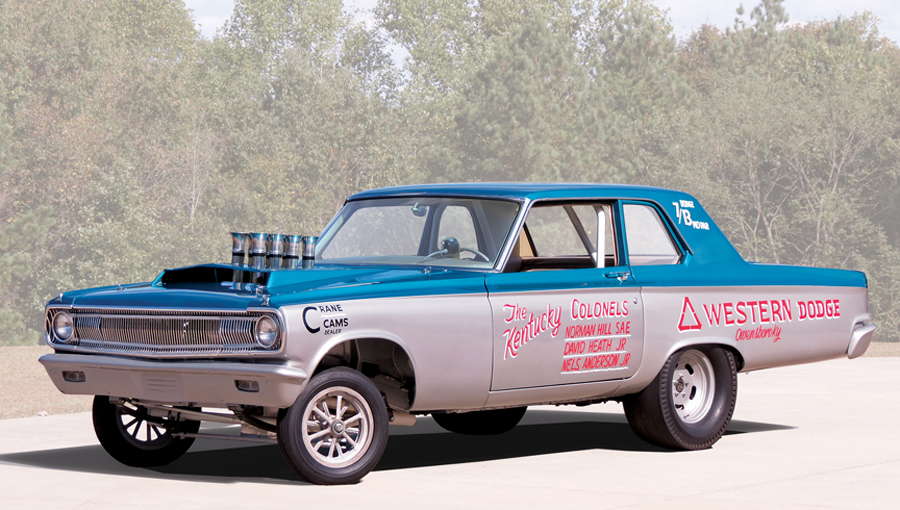- A990 426 Hemi package
- Restored to race appearance
- Rare period racing components
- W051 Coronet Super Stock
- Displayed at Floyd Garrett’s Muscle Car Museum
SCM Analysis
Detailing
| Vehicle: | 1965 Dodge Coronet Super Stock Hemi |
| Years Produced: | 1965 |
| Number Produced: | 101 |
| Original List Price: | $4,100 (Hemi, approximately) |
| SCM Valuation: | $118,800 |
| Tune Up Cost: | $500 |
| Chassis Number Location: | Plate on left front door hinge pillar |
| Engine Number Location: | Top of bellhousing |
| Alternatives: | 1965 Plymouth A/FX, 1965 Ford Mustang A/FX, 1964 Ford Fairlane Thunderbolt |
| Investment Grade: | C |
This car, Lot 1026.1, sold for $55,000, including buyer’s premium, at Barrett-Jackson’s Scottsdale, AZ, sale held January 17–19, 2020.
The first Funnies
There are few constants in the world, but racers pushing the definition of “stock” might well be one of them.
As factory involvement in drag racing grew in the 1960s, the National Hot Rod Association found itself scrambling to keep the rule book up to date with the racers’ innovations. Simply saying a car had to be stock wasn’t enough if the factory up and built cars with aluminum or acid-dipped panels, lightweight glass and giant engines and then sold them to the public.
Even worse, from a rule-keeping perspective, if you didn’t specify that the parts all had to have come on that exact car in that configuration from the assembly line, clever racers would throw in the biggest engine from the brand, often with a decidedly unstreetable compression ratio. Then they’d add suspiciously lightweight components under the hood and a straight front axle from the truck-parts bin under the front end, maybe moved up just a smidge for better weight transfer, and call it within the rules.
NHRA made a class for these Frankencars in 1962 called “FX” for “Factory Experimental.” Direct factory involvement was short-lived. GM pulled out of official race support, and Ford and Chrysler realized it might not be a good look to outshine all their customers in the most extreme “stockers” on track. Ultimately, that only meant that independent racers like Bob Tasca, Dick Landy and Ronnie Sox got more behind-the-scenes support.
The FX cars got wildly modified and wildly popular with the fans. By 1965, they were so stretched and lifted and be-engined that they looked “funny,” and you can see how they evolved into the tube-chassis and full-fiberglass-bodied Funny Cars of today.
Wedges and Hemis
Chrysler started the ‘60s with powerful 383 and 413 big blocks. In ’62, it came out with the Max Wedge 413 in a lighter sedan and dominated the Super Stock classes. In 1963, displacement increased to the famous 426 number, and in 1964, speaking of famous engines, Chrysler introduced the 426 Hemi.
The Super Stock cars were already limited production and came from the factory with lightweight metal panels, thinner glass and race-ready engines, but in late ’64, the engineers built 12 (six Plymouth and six Dodge) cars for Factory Experimental with a massive wheelbase alteration. The altered-wheelbase cars traveled the country more for match races rather than NHRA competition, but they caught the imagination of fans and fellow racers, and, shall we say, altered the drag-race landscape.
The factory-prepared cars went to factory-sponsored racers like Landy and Sox, but there were many additional modified cars built by other racers, and that’s where the blue-and-silver Coronet that we have here enters the picture.
Rare racer
This Coronet left Dodge as a W051 lightweight Super Stock car with the 426 A990 package. A990 refers to the 426 Hemi and related beefy drivetrain parts and rear gearing.
The cars equipped this way are often called A990 cars, but if you’re a stickler, go with W051.
The Coronet was shipped to a dealer in Kentucky, along with a selection of fiberglass parts for the wheelbase conversion. The ’65 Super Stockers were acid-dipped steel, and Dodge worked closely with aftermarket race shops to create additional go-fast modifications.
Details on the restoration include a date-coded 426 Hemi race block — December 1964 — with a forged-steel crankshaft, Crane cam, high-compression pistons topped by Alcoa aluminum heads, and a rare Prestolite distributor and ignition. Hilborn stack injection towers over the hood and spent gasses make their historically accurate way out through original S&S A/FX headers. The Hemi is backed by an A990 torque convertor, a rebuilt Art Carr TorqueFlite automatic transmission and 4.56 rear gears.
Inside, the Coronet is caged and race-focused, with lightweight seats, a Hurst dual-gate shifter and a dash-mounted tachometer. The interior is spare, but elegant and color-matched in silvery gray.
Collecting history
This Coronet falls in a funny spot for collectors. It’s possibly too period to be safely competitive on a racetrack, even in a nostalgia class, and yet not famous enough to be the centerpiece of a museum collection the way a Landy or “Dyno” Don car would be.
Because of the high compression ratio, mechanical injection and gasser stance, it would take a dedicated enthusiast — and friendly local police force — to use this car on the street.
We’ve seen unmodified Super Stock lightweights sell for twice the price of this rarer altered racer, and that might reflect a buyer’s insecurity as to what exactly he or she is going to do with such an outrageous machine.
Still, it is a 426 Hemi car, and an excellent entry point into one of the most interesting time periods in drag-racing history. For that, I’ll call it well bought.
(Introductory description courtesy of Barrett-Jackson.)
